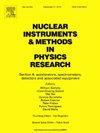New detector development and performance evaluation for KamLAND2-Zen experiment
IF 1.4
3区 物理与天体物理
Q3 INSTRUMENTS & INSTRUMENTATION
Nuclear Instruments & Methods in Physics Research Section A-accelerators Spectrometers Detectors and Associated Equipment
Pub Date : 2025-07-18
DOI:10.1016/j.nima.2025.170850
引用次数: 0
Abstract
To prove the Mayorana nature of neutrinos, the KamLAND-Zen experiment is searching for neutrinoless double beta () decays. The KamLAND-Zen 800 experiment phase used one of the world’s most sensitive detectors, the KamLAND detector, and a decay nucleus, 745 kg of enriched xenon and we measured until 2024. We then set the world’s most stringent limits on the lower half-life of decay and the upper limit of the effective Mayolana mass. This experiment is currently being upgraded to the next-generation detector KamLAND2 detector to further improve sensitivity. Because we needed to test these upgrades before installing KamLAND2 detector, we constructed a prototype detector and tested high quantum efficiency photomultiplier tubes (HQE-PMTs), light-collection Winston Cone mirrors on the HQE-PMTs, and high emission liquid scintillator. The evaluation results of the detector’s light yield showed that the installation of light-collection mirrors alone can increase the light yield by a factor 1.7 to 2.6. Furthermore, the results also showed remarkable stability within the margin of error over a long period of about one year. However, several hardware problems were identified. One of these problems was that the mirrors of adjacent HQE-PMTs contacted each other, and the entirety of those mirrors were severely distorted. Based on this, we decided to use a flexible film mirror for the mirror contact area. The new mirror was shown to avoid significant distortion in an installation test using a model, and we plan to conduct an installation test and detailed performance evaluation using the actual mirror in the future.
KamLAND2-Zen实验新型探测器研制及性能评价
为了证明中微子的Mayorana性质,KamLAND-Zen实验正在寻找无中微子的双β (0νββ)衰变。KamLAND- zen 800实验阶段使用了世界上最灵敏的探测器之一,KamLAND探测器,和一个0νββ衰变核,745千克富集氙,我们测量到2024年。然后,我们对0νββ衰变的下半衰期和有效马约拉纳质量的上限设定了世界上最严格的限制。该实验目前正在升级为下一代探测器KamLAND2探测器,以进一步提高灵敏度。由于我们需要在安装KamLAND2探测器之前测试这些升级,我们构建了一个原型探测器并测试了高量子效率光电倍增管(hqi - pmts), hqi - pmts上的光收集温斯顿锥反射镜和高发射液体闪烁体。探测器的出光率评价结果表明,单独安装集光镜可使出光率提高1.7 ~ 2.6倍。此外,在大约一年的长时间内,结果也显示出在误差范围内的显著稳定性。然而,发现了几个硬件问题。其中一个问题是相邻的hqe - pmt的反射镜相互接触,并且这些反射镜的整体严重扭曲。基于此,我们决定使用柔性薄膜反射镜作为反射镜接触区域。在使用模型的安装测试中,新镜子被证明可以避免明显的变形,我们计划在未来使用实际镜子进行安装测试和详细的性能评估。
本文章由计算机程序翻译,如有差异,请以英文原文为准。
求助全文
约1分钟内获得全文
求助全文
来源期刊
CiteScore
3.20
自引率
21.40%
发文量
787
审稿时长
1 months
期刊介绍:
Section A of Nuclear Instruments and Methods in Physics Research publishes papers on design, manufacturing and performance of scientific instruments with an emphasis on large scale facilities. This includes the development of particle accelerators, ion sources, beam transport systems and target arrangements as well as the use of secondary phenomena such as synchrotron radiation and free electron lasers. It also includes all types of instrumentation for the detection and spectrometry of radiations from high energy processes and nuclear decays, as well as instrumentation for experiments at nuclear reactors. Specialized electronics for nuclear and other types of spectrometry as well as computerization of measurements and control systems in this area also find their place in the A section.
Theoretical as well as experimental papers are accepted.

 求助内容:
求助内容: 应助结果提醒方式:
应助结果提醒方式:


